In the present day, none much has been said about the issues of racial inequality towards black people even in copper-skinned communities. People interviewed by the media, reality shows, or even those who spoke with authors of articles have no problem interacting with the black community. However, history told us the other way around. In this article, we have compiled a list of ten African-American expulsions where the level of cruelty reached new heights.
Here are the ten cruelest African-American expulsions ever happen.
- Tulsa Race Massacre, Oklahoma (May 31, 1921)
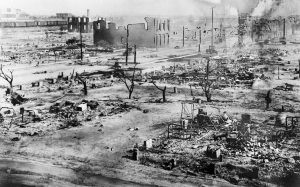
The aftermath of the Tulsa Race Massacre, during which mobs of white residents attacked black residents and businesses of the Greenwood District in Tulsa, Oklahoma, US, June 1921. (Photo by Bettmann Archive/Getty Images)
The Tulsa race massacre occurred on May 31 and June 1, 1921, when vigilantes of white residents, some of whom had been relieved of duty and given weapons by city officials, struck Black residents and destroyed homes and businesses in Tulsa, Oklahoma, US. It is also known as the Tulsa pogrom, the Tulsa race riot, or the Black Wall Street massacre. The assailants set fire to more than 35 square blocks of the neighborhood, which was known as “Black Wall Street” at the time and was one of the wealthiest Black communities in the United States. After 19-year-old Black shoeshiner Dick Rowland was accused of attacking Sarah Page, a 17-year-old white elevator operator in the adjoining Drexel Building, the slaughter began over Memorial Day weekend. He was apprehended and put into custody. More than 800 people were hospitalized to hospitals, and 6,000 Black Tulsa residents were detained in enormous facilities, some for several days. The Oklahoma Bureau of Vital Statistics has confirmed that 36 people have died. Based on current autopsy reports, death certificates, and other data, a 2001 state commission investigation was able to confirm 39 deaths, 26 Black and 13 White. The death toll was estimated to be between 75 and 300 people, according to the committee.
- Rosewood Massacre (January 1923)
 The Rosewood Slaughter was a racially driven massacre of black people and the demolition of a black village that occurred in rural Levy County, Florida during the first week of January 1923. At least six black individuals and two white persons were slain, however eyewitness sources stated that the death toll was far higher, ranging from 27 to 150. The town of Rosewood was destroyed in a race riot, according to contemporary news reports. In the years leading up to the massacre, Florida saw a particularly high number of public executions of black males, including a well-publicized episode in December 1922. According to official records, eight people died during the first week of January 1923. (six blacks and two whites). According to some survivors’ accounts, up to 27 black citizens were slain, while newspapers failed to disclose the total number of white killings.
The Rosewood Slaughter was a racially driven massacre of black people and the demolition of a black village that occurred in rural Levy County, Florida during the first week of January 1923. At least six black individuals and two white persons were slain, however eyewitness sources stated that the death toll was far higher, ranging from 27 to 150. The town of Rosewood was destroyed in a race riot, according to contemporary news reports. In the years leading up to the massacre, Florida saw a particularly high number of public executions of black males, including a well-publicized episode in December 1922. According to official records, eight people died during the first week of January 1923. (six blacks and two whites). According to some survivors’ accounts, up to 27 black citizens were slain, while newspapers failed to disclose the total number of white killings.
- Ku Klux Klan (1923)
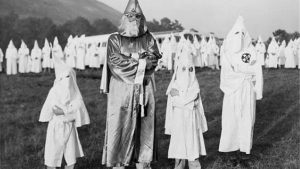 The Ku Klux Klan has arisen in three different periods. White nationalism, anti-immigration, and – especially in later iterations – Nordicism, antisemitism, anti-Catholicism, Prohibition, right-wing populism, anti-communism, homophobia, Islamophobia, and anti-atheism have all been supported by each. In the late 1860s, the early Ku Klux Klan used terrorism — both physical attack and murder – against politically engaged blacks and their sympathizers in the South. All three movements demand or the “purification” of American society, and they are all considered right-wing extremist groups. Membership was kept secret in each age, and estimates of the total were often overstated by both friends and foes. The original Ku Klux Klan was founded in the aftermath of the American Civil War and was a pivotal figure in the Reconstruction era. It was organized in the southern United States and was suppressed in the early 1870s by federal involvement. In 1915, the second Ku Klux Klan formed in Georgia. It flourished in the early and mid-1920s across the country, including urban regions in the Midwest and West. After 1950, the third and present manifestation of the KKK arose in the shape of small, isolated groups that used the KKK moniker. They have mostly targeted opponents of the civil rights movement, frequently employing violence and murder to silence people.
The Ku Klux Klan has arisen in three different periods. White nationalism, anti-immigration, and – especially in later iterations – Nordicism, antisemitism, anti-Catholicism, Prohibition, right-wing populism, anti-communism, homophobia, Islamophobia, and anti-atheism have all been supported by each. In the late 1860s, the early Ku Klux Klan used terrorism — both physical attack and murder – against politically engaged blacks and their sympathizers in the South. All three movements demand or the “purification” of American society, and they are all considered right-wing extremist groups. Membership was kept secret in each age, and estimates of the total were often overstated by both friends and foes. The original Ku Klux Klan was founded in the aftermath of the American Civil War and was a pivotal figure in the Reconstruction era. It was organized in the southern United States and was suppressed in the early 1870s by federal involvement. In 1915, the second Ku Klux Klan formed in Georgia. It flourished in the early and mid-1920s across the country, including urban regions in the Midwest and West. After 1950, the third and present manifestation of the KKK arose in the shape of small, isolated groups that used the KKK moniker. They have mostly targeted opponents of the civil rights movement, frequently employing violence and murder to silence people.
- Colfax Massacre (April 13, 1873)
 On Easter Sunday of April 13, 1873, in Colfax, Louisiana, the parish seat of Grant Parish, the Colfax massacre, also known as the Colfax riot, happened. While surrendering to a mob of former Confederate troops and Ku Klux Klan members, an estimated 62-153 black militiamen were slain. Three white guys were also killed in the clash. A gang of white men armed with assault rifles and a small cannon defeated African freedmen and state soldiers manning the Grant Parish courthouse in Colfax in the aftermath of the controversial 1872 election for governor of Louisiana and municipal offices. After surrendering, the majority of the freedmen were slaughtered, and approximately another 50 were killed later that night after being held captive for several hours. Estimates of the number of fatalities have ranged from 62 to 153 throughout the years; three whites died, but the number of black victims was difficult to ascertain because many remains were tossed into the Red River or transferred for burial, probably in mass graves.
On Easter Sunday of April 13, 1873, in Colfax, Louisiana, the parish seat of Grant Parish, the Colfax massacre, also known as the Colfax riot, happened. While surrendering to a mob of former Confederate troops and Ku Klux Klan members, an estimated 62-153 black militiamen were slain. Three white guys were also killed in the clash. A gang of white men armed with assault rifles and a small cannon defeated African freedmen and state soldiers manning the Grant Parish courthouse in Colfax in the aftermath of the controversial 1872 election for governor of Louisiana and municipal offices. After surrendering, the majority of the freedmen were slaughtered, and approximately another 50 were killed later that night after being held captive for several hours. Estimates of the number of fatalities have ranged from 62 to 153 throughout the years; three whites died, but the number of black victims was difficult to ascertain because many remains were tossed into the Red River or transferred for burial, probably in mass graves.
- Ocoee Massacre (November 2-3, 1920)
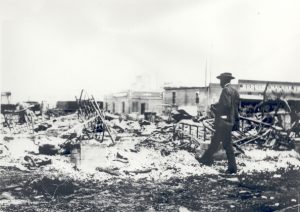 The Ocoee Massacre happened on November 2, 1920, the day of the United States presidential election, when a white mob attacked African-American inhabitants in northern Ocoee, Florida. The attack was carried out in order to deter black people from voting. The community is located in Orange County, not far from Orlando. According to most estimations, 30–35 black people were killed. The majority of African American-owned houses and homes in northern Ocoee were destroyed by fire. Other African Americans in southern Ocoee were later killed or forced to flee due to the prospect of further violence. Ocoee basically became a white-only community. The tragedy has been dubbed the bloodiest day in modern American political history.
The Ocoee Massacre happened on November 2, 1920, the day of the United States presidential election, when a white mob attacked African-American inhabitants in northern Ocoee, Florida. The attack was carried out in order to deter black people from voting. The community is located in Orange County, not far from Orlando. According to most estimations, 30–35 black people were killed. The majority of African American-owned houses and homes in northern Ocoee were destroyed by fire. Other African Americans in southern Ocoee were later killed or forced to flee due to the prospect of further violence. Ocoee basically became a white-only community. The tragedy has been dubbed the bloodiest day in modern American political history.
- Pana Riot (April 10, 1899)
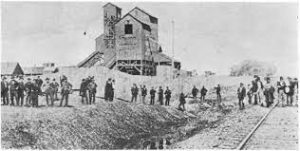 The Pana riot, also known as the Pana massacre, was labor and racial struggle that erupted on April 10, 1899, in Pana, Illinois, and claimed the lives of seven people. It was one of many such labor disputes that erupted in Illinois’ coal mining districts in 1898 and 1899. Mine owners replied by recruiting guards as well as some 300 African-American miners from Alabama to act as strikebreakers when the United Mine Workers of America called a strike that affected many mines. The miners blamed black strikebreakers for the death of a white union miner after a skirmish in which a white union miner was killed. The violence resulted in the deaths of two whites and five blacks, as well as the injuries of another six African Americans.
The Pana riot, also known as the Pana massacre, was labor and racial struggle that erupted on April 10, 1899, in Pana, Illinois, and claimed the lives of seven people. It was one of many such labor disputes that erupted in Illinois’ coal mining districts in 1898 and 1899. Mine owners replied by recruiting guards as well as some 300 African-American miners from Alabama to act as strikebreakers when the United Mine Workers of America called a strike that affected many mines. The miners blamed black strikebreakers for the death of a white union miner after a skirmish in which a white union miner was killed. The violence resulted in the deaths of two whites and five blacks, as well as the injuries of another six African Americans.
- East St. Louis Race Riots (July 1917)
 In late May and early July 1917, the East St. Louis Riots were a series of labor and race-related riots in which White Americans assassinated between 39 and 150 African Americans. Another 6,000 black people were displaced, and the property damage from the fires and vandalism totaled $400,000 ($8,080,000 in 2022). The incidents occurred in and around East St. Louis, Illinois, an industrial community on the Mississippi River’s east bank, just opposite St. Louis, Missouri. White-led violence erupted across the city during the July 1917 event in particular. The multi-day riot has been dubbed the worst case of labor-related brutality in American history in the twentieth century, as well as one of the worst race riots in American history. The East St. Louis Chamber of Commerce demanded for the local police chief’s resignation in the aftermath, claiming that cops were directed not to shoot white rioters and were powerless to stop the violence and destruction. A large number of black individuals have permanently fled the city. By the time school started in the autumn, black enrollment in the area’s public schools had decreased by 35%. Approximately 10,000 black citizens gathered in silent protest in New York City at the end of July, condemning the unrest.
In late May and early July 1917, the East St. Louis Riots were a series of labor and race-related riots in which White Americans assassinated between 39 and 150 African Americans. Another 6,000 black people were displaced, and the property damage from the fires and vandalism totaled $400,000 ($8,080,000 in 2022). The incidents occurred in and around East St. Louis, Illinois, an industrial community on the Mississippi River’s east bank, just opposite St. Louis, Missouri. White-led violence erupted across the city during the July 1917 event in particular. The multi-day riot has been dubbed the worst case of labor-related brutality in American history in the twentieth century, as well as one of the worst race riots in American history. The East St. Louis Chamber of Commerce demanded for the local police chief’s resignation in the aftermath, claiming that cops were directed not to shoot white rioters and were powerless to stop the violence and destruction. A large number of black individuals have permanently fled the city. By the time school started in the autumn, black enrollment in the area’s public schools had decreased by 35%. Approximately 10,000 black citizens gathered in silent protest in New York City at the end of July, condemning the unrest.
- Pierce City, Missouri (1901)
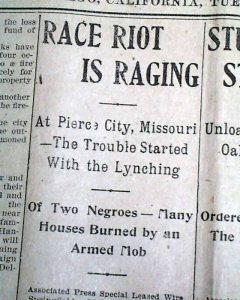 Three African-American males were killed at Pierce City on August 19, 1901, by a massive white mob. The killing of a young white woman was suspected of French and William Godley, as well as Peter Hampton. Two of the guys were in their eighties and were doubtful suspects; none of them stood a chance in court. These are the only lynching in Lawrence County that have been documented. Unrest persisted, and a white mob set fire to five black homes and pushed “30 families into the woods,” displacing the town’s about 300 black population. (It had roughly 1,000 white people.) The majority of African Americans lost all of their land and property, and whites just took up the vacant lots. This was part of a trend of brutality in southwest Missouri in the early twentieth century, which included large-scale public lynching in Joplin and Springfield, leading to the exodus of many African Americans from the area. In Lawrence County, there were just 91 African Americans left by 1910, and their proportions continued to fall. Ethnic cleansing has been labeled as a result of the tragedy.
Three African-American males were killed at Pierce City on August 19, 1901, by a massive white mob. The killing of a young white woman was suspected of French and William Godley, as well as Peter Hampton. Two of the guys were in their eighties and were doubtful suspects; none of them stood a chance in court. These are the only lynching in Lawrence County that have been documented. Unrest persisted, and a white mob set fire to five black homes and pushed “30 families into the woods,” displacing the town’s about 300 black population. (It had roughly 1,000 white people.) The majority of African Americans lost all of their land and property, and whites just took up the vacant lots. This was part of a trend of brutality in southwest Missouri in the early twentieth century, which included large-scale public lynching in Joplin and Springfield, leading to the exodus of many African Americans from the area. In Lawrence County, there were just 91 African Americans left by 1910, and their proportions continued to fall. Ethnic cleansing has been labeled as a result of the tragedy.
- Vienna, Illinois (1954)
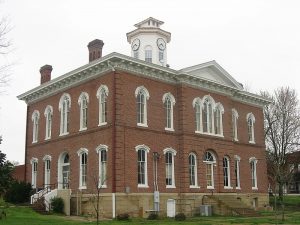 All the black dwellings in Vienna and the surrounding areas were set on fire by white citizens. The death of an elderly white widow and the attempted rape of her adolescent granddaughter by two black men prompted the expulsion. Much is kept unsaid in Vienna, as it is in hundreds of predominantly white towns across America with similar histories. Nearly no one in this community speaks freely about the savagery that drove out Black inhabitants nearly 70 years ago, or even mentions the moniker given to these places – sundown towns. A sundown town’s laws were straightforward, black people were permitted to come in during the day to buy or work, but they had to leave by nightfall. Anyone who disobeys the regulations risks being arrested, beaten, or worse. For at least a century, these towns were an unwritten rule of racial segregation that spread across most of the country, and they still exist in various forms today, enforced more by tradition and less by law. Across America, some of these towns are now openly wrestling with their histories, publicly acknowledging now-abandoned racist laws or holding racial justice protests. Some old sundown towns are now integrated. But many also still have tiny Black communities living alongside residents who don’t bother hiding their cold stares of disapproval.
All the black dwellings in Vienna and the surrounding areas were set on fire by white citizens. The death of an elderly white widow and the attempted rape of her adolescent granddaughter by two black men prompted the expulsion. Much is kept unsaid in Vienna, as it is in hundreds of predominantly white towns across America with similar histories. Nearly no one in this community speaks freely about the savagery that drove out Black inhabitants nearly 70 years ago, or even mentions the moniker given to these places – sundown towns. A sundown town’s laws were straightforward, black people were permitted to come in during the day to buy or work, but they had to leave by nightfall. Anyone who disobeys the regulations risks being arrested, beaten, or worse. For at least a century, these towns were an unwritten rule of racial segregation that spread across most of the country, and they still exist in various forms today, enforced more by tradition and less by law. Across America, some of these towns are now openly wrestling with their histories, publicly acknowledging now-abandoned racist laws or holding racial justice protests. Some old sundown towns are now integrated. But many also still have tiny Black communities living alongside residents who don’t bother hiding their cold stares of disapproval.
- Forsyth County, Georgia (1912)
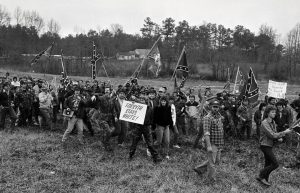 In September 1912, two distinct alleged attacks on white ladies in Forsyth County, Georgia, resulted in black men being named as suspects. Two black guys are suspected of breaking into a white woman’s home in Big Creek Community and rapping her. In the Oscarville Community, another teen woman was severely beaten and raped. A hair comb sold to Earnest Knox at the Oscarville store linked him to the Oscarville murder, as did his half-brother. He confessed to the Sheriff and accused his half-brother and mother’s live-in partner when confronted. During the jury trial that resulted in both sons being sentenced to death by hanging, his mother testified against them. The sentence was executed out 21 days later. In the Big Creek attack, a black preacher and his followers drove to Cumming to demand the release of the men accused of raping a little girl from the Big Creek Community. If the man was not released, he threatened to destroy the town. As a result, a white counter-mob appeared and confronted them. The preacher was severely beaten after being overheard suggesting that the first woman may have had a consensual relationship with a black man. To protect the preacher from the crowd gathering outside, the Forsyth County Sheriff locked him inside the courthouse for the night. Rob Edwards was being imprisoned in the little 20×20 foot jail in Cumming after being convicted for the subsequent murder and rape. A white mob kidnapped him from the jail and shot and beat him to death. In 1910, the county, which had over 10,000 white residents, had over 1,000 black residents. Following the trials and deaths, groups of white men known as Night Riders from Cherokee and neighboring counties attacked and terrorized Black residents.
In September 1912, two distinct alleged attacks on white ladies in Forsyth County, Georgia, resulted in black men being named as suspects. Two black guys are suspected of breaking into a white woman’s home in Big Creek Community and rapping her. In the Oscarville Community, another teen woman was severely beaten and raped. A hair comb sold to Earnest Knox at the Oscarville store linked him to the Oscarville murder, as did his half-brother. He confessed to the Sheriff and accused his half-brother and mother’s live-in partner when confronted. During the jury trial that resulted in both sons being sentenced to death by hanging, his mother testified against them. The sentence was executed out 21 days later. In the Big Creek attack, a black preacher and his followers drove to Cumming to demand the release of the men accused of raping a little girl from the Big Creek Community. If the man was not released, he threatened to destroy the town. As a result, a white counter-mob appeared and confronted them. The preacher was severely beaten after being overheard suggesting that the first woman may have had a consensual relationship with a black man. To protect the preacher from the crowd gathering outside, the Forsyth County Sheriff locked him inside the courthouse for the night. Rob Edwards was being imprisoned in the little 20×20 foot jail in Cumming after being convicted for the subsequent murder and rape. A white mob kidnapped him from the jail and shot and beat him to death. In 1910, the county, which had over 10,000 white residents, had over 1,000 black residents. Following the trials and deaths, groups of white men known as Night Riders from Cherokee and neighboring counties attacked and terrorized Black residents.
In the United States, African Americans have been brutally evicted from at least 50 towns, cities, and counties. The majority of the expulsions took place in the 60 years after the Civil War, but they persisted until 1954. In addition, small type of expulsions is still happening behind media. These may took place in schools, supermarkets and often in social media where youth receives greater long-term effects. The racial and ethnic inequalities stained the history. But the truth is, none of the race are superior, even the darkest-colored genes can offer something authentic to the world.



